BY ROBERT ABELE
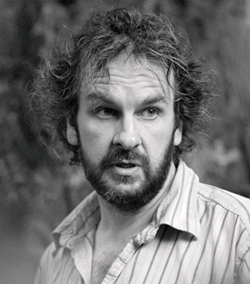 Peter Jackson was 9 years old when he saw the horror-adventure classic King Kong for the first time on a small television screen, and cried for the great ape as he plunged to his death. The experience cinched his desire to make movies. Decades later, with a few Oscars under his belt for the epic Lord of the Rings trilogy, the New Zealander finally had a chance to re-imagine that touchstone in special effects filmmaking–this time with photorealistic computer imagery instead of the crudely effective miniatures and stop-motion wizardry of the 1933 original.
Peter Jackson was 9 years old when he saw the horror-adventure classic King Kong for the first time on a small television screen, and cried for the great ape as he plunged to his death. The experience cinched his desire to make movies. Decades later, with a few Oscars under his belt for the epic Lord of the Rings trilogy, the New Zealander finally had a chance to re-imagine that touchstone in special effects filmmaking–this time with photorealistic computer imagery instead of the crudely effective miniatures and stop-motion wizardry of the 1933 original.
Naturally, the Empire State Building climax was foremost in Jackson’s mind, and it was the first sequence he and a small animatics team, led by animation director Christian Rivers, began working on when Jackson was still in post-production on The Return of the King. No script was written yet, but Jackson wanted the choreography, angles and virtual camera movement of this crucial bit of action-packed, emotional storytelling hammered into pre-viz shape before the animation and visual effects teams at Weta–the Wellington, New Zealand filmmaking complex he founded–spent 18 months fleshing it out into the textured, seamless, eye-popping 14-minute capper. In the end, little else besides a soundstage-filmed Naomi Watts as Ann Darrow and a few props were real.
That said, a special 5 a.m. research visit to the top of the actual Empire State Building (soon after his big Oscar night in 2004), proved enormously helpful when it came to getting the lighting at dawn, digitally recreating the famous monument and expanding the possibilities for skyscraping mayhem. Here, Jackson explains what he was after as he pieced together his fresh take on a mythic cinematic moment.
This was the first big reveal of the Empire State Building, the big pullback, and I wanted the building to seem monolithic. It was designed to be our version of that long shot [from the 1933 film]. I wanted to give the feeling of one of nature’s greatest creations, this huge gorilla, now scaling one of mankind's greatest creations. The army searchlights were certainly helpful in making the building still even more grand, and whether this is true or not, I liked the idea that they weren't quite powerful enough to reach the top.
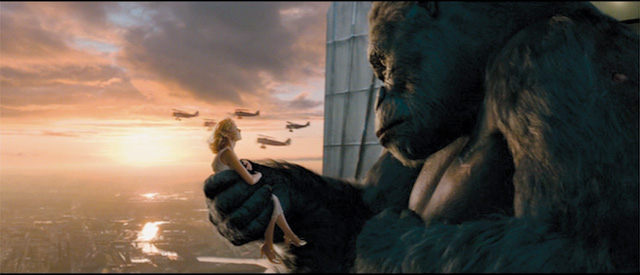
We had a chair on a pole that Naomi could sit in, that would approximate the way her body was draped in his fingers, and around the front of the chair was a blue piece of foam rubber, like a big sausage. We never used a mechanical hand. The clouds are a photograph of a Wellington dawn in New Zealand. I didn’t want to give the arrival of the planes away, so they just burst into the background right between their eyelines during this long, slow push in towards Ann and Kong. He’s empathizing with another living being for the first time, and the planes are an ominous introduction to what’s going to happen next.
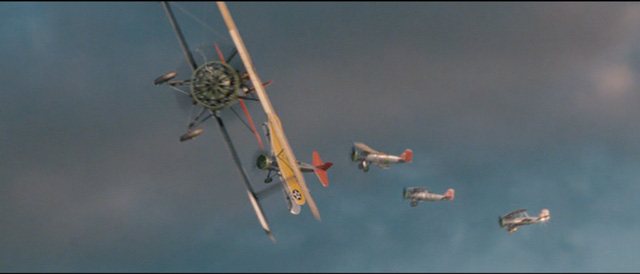
There were no flying planes. One thing that computer-generated planes allow you to do is slightly more dangerous shots. In this, the first plane just scoots right past the camera lens as the shot progresses. You not only get more dynamic shots, but you’re not putting anybody in any risk flying old aircraft. These particular CG planes are Curtis Helldivers, which were the American naval planes of 1933. The markings are accurate, but we discovered that not one single plane exists anywhere in the world, so we went to the Curtis factory and got the drawings, which do still exist.
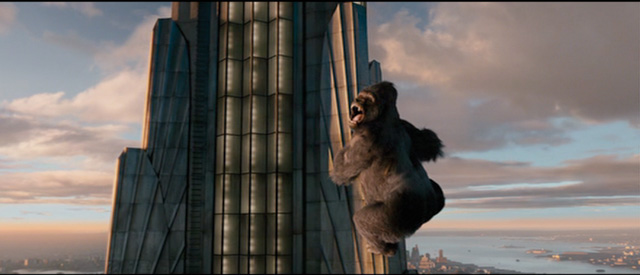
All of Manhattan is artificial, and all of the Empire State Building is computerized. All the skies are real, mainly New Zealand skies. One of us would be driving on a street in Wellington, and I’d look up and get on the phone to Weta and say, “My God, there’s some incredible clouds, get someone to photograph them!” We’d do four, five or six shots of a skyscape with a still camera, and we built up a library of clouds. Andy [Serkis, who played Kong] did do some climbing. We created a sort of ladder for him on the motion capture stage for this particular shot.
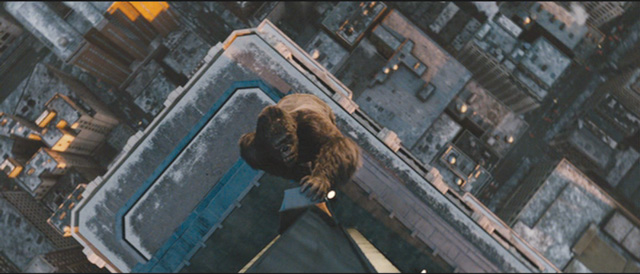
The Empire State Building is so phenomenally high that you can’t help but try to exploit that where possible, and it's the looking-down angles that give you the height. We did a slow rotation around because any camera movement gives you a shifting perspective, and that more than anything makes you feel vertiginous, unlike a still image. It just has to be subtle. You’re not doing it because of the action on screen, but to make people feel queasy about how high you are.
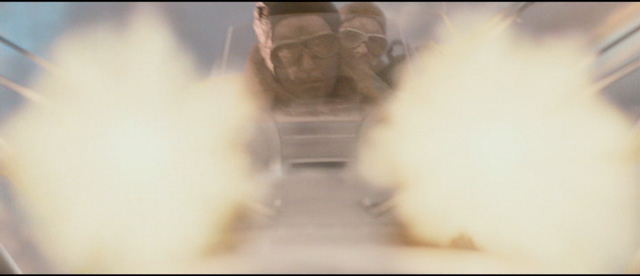
In the studio we had our mock-up plane that we’d built on a gimbal against blue screen. We were shaking the plane around, putting a lot of wind machines on it. In the old days it would have been rear projection behind them. The guns were real guns, firing blanks. We had a hugely powerful light on the end of a big camera crane, gelled to be that early morning orangey-pink sun, and we swung this huge crane arm around so that the movement of the sun was sweeping over the cockpit and the pilots. The changing light patterns gave you that sense of the plane’s movement.
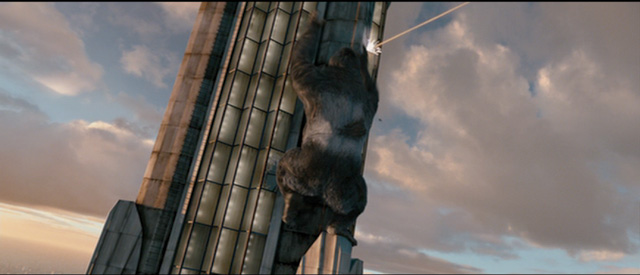
Until the advent of computers, everyone was firing blanks so you never saw tracer bullets in films. Now you're able to see the tracer fire, which is cool, because it really gives a visceral feeling. We were trying to think of ways in which we could break away from having him be stuck on the top of the building, so we made something of a meal out of what they call the mooring mast. It was there for dirigibles mooring at the top of the building, and it seemed interesting to me to have the attack start there, while he's climbing.
It’s always good to look for shots where you can blend something CG with your actors in the same shot, because otherwise you end up in a cutting pattern, from actor to CG and back to actor. This shot begins completely as a computer shot looking up, and then we tilt down to Naomi on a little piece of set we built. We dropped fake glass down, but ultimately added a lot more CG glass later on.
None of us knew that ladder existed on the building, and when we were working on the animatics, we always assumed there was a ladder inside the mast, or she'd run up a stairwell. But when we visited the Empire State Building, the ladder was there, and it was Naomi herself who said, "Hey, I could climb that." In the studio, we built a ten or twelve-foot section of ladder, enough that we could get four seconds of her climbing, and everything else isn't real. We didn't want her climbing too high, for safety reasons.
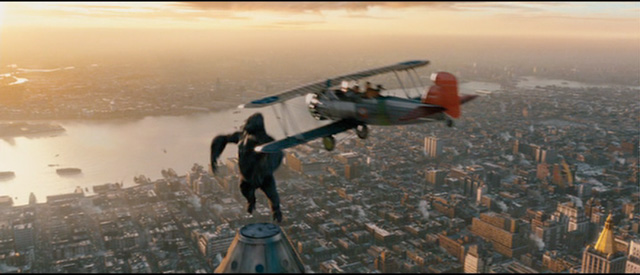
This one is a good example of us trying to think of ways to choreograph action with Kong stuck on top of the building. I thought it would be a great surprise to have him do a huge leap and swat at a plane. It’s a good aspect of the lighting, too. Joe Letteri, our visual effects supervisor, is very strong on lighting, and he wanted to keep this sequence at dawn, which means very high-contrast. We could have rotated Kong around and have the shot from a different direction, but we wanted that backlit sun to be washing across the wings of the plane, and glinting off the river. You’re always looking for mood and atmosphere.
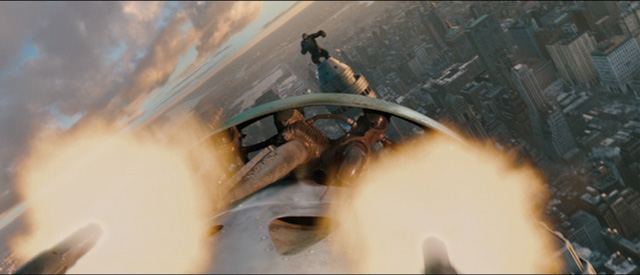
This is a close-up of the airplane engine and cowling and studio guns shot against a blue screen, with our moving light source, while Kong and Manhattan are CG. I wanted to move the camera around a lot, and for you to feel sometimes that you were inside the plane, buffeting and shaking around and coming towards the gorilla, taking the pilot's point-of-view. I wanted to try to create a sequence that was as visceral as possible.
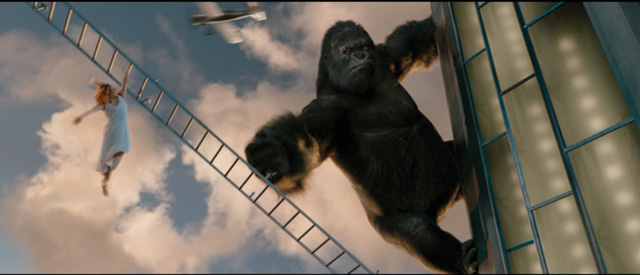
Once we saw the ladder, and we had the idea of Naomi climbing the ladder, the next idea came: what say the ladder starts to fall away from the building? We shot Naomi as an insert, hanging onto the ladder, just about two feet off a mattress covered in blue, and the ladder was only half that length. Everything else is computer-generated. It follows a moment where Kong is getting shot at and just manages to cling on with his fingertips, which coincides with Ann scrambling up the ladder to be with him. It’s good to connect Ann and Kong, that she’s in danger and he has to save her.
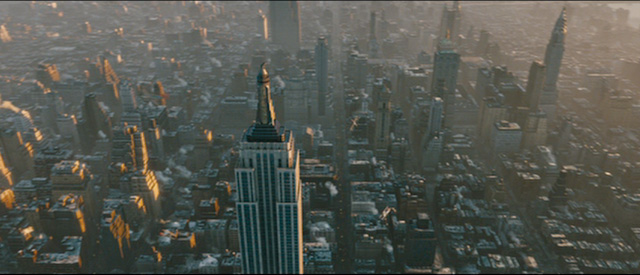
It took us a year-and-a-half to create the New York you’re seeing in these shots. All the key buildings are accurately represented. The easiest reference was to get street plans, photographs, details of how it is today, but we left gaps for buildings built after 1933. And then we built generic buildings or brownstones, whatever, to fill in the gaps. We programmed the computer to what an average New York office building would look like, and then we built variation in so the architecture would differ building-to-building. We didn’t have the manpower to do every single building ourselves.
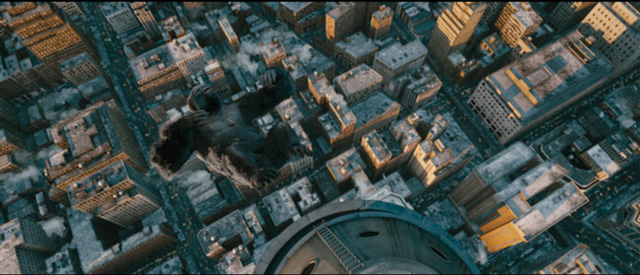
I wanted his fall to have a sense of gentleness, not violent or ugly in any way, so we’re into slow motion at this point. We kept him motionless deliberately, because he dies in front of Ann before his lifeless body slides off the top. The Naomi at the top of the building is computer-generated–we built a very accurate double of her for these sorts of shots. On the soundtrack we took the engine noises away from the planes, just had this gentle woosh-woosh-woosh of the propeller. I wanted it to be a very long shot, long and slow and painful to watch, and it finishes before he hits the street, because I didn’t want to have him hitting the bottom.